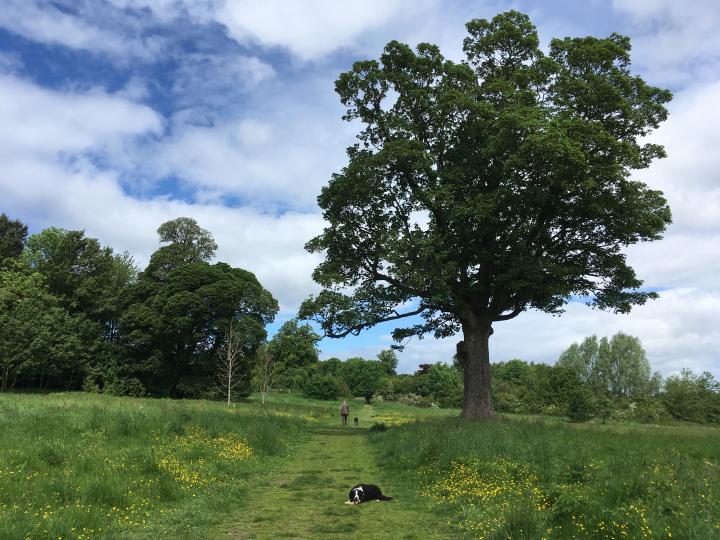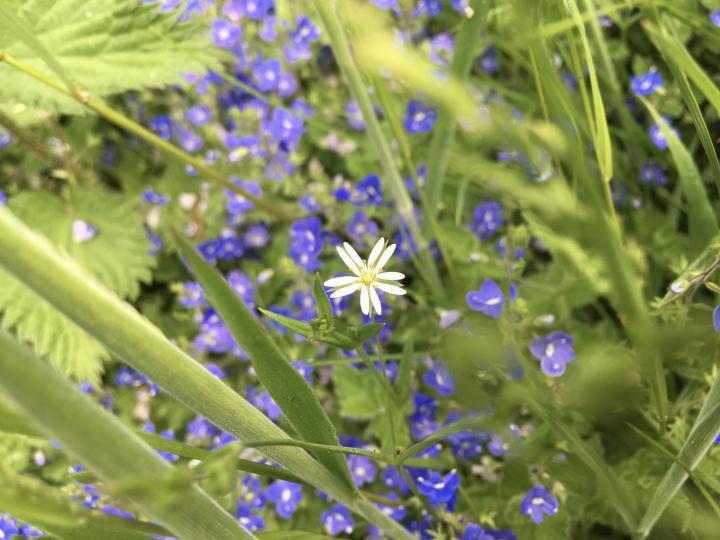A June Contemplation
MindLetter post written by Dr Kitty Wheater.
Dear all,
The air is warm, the sky is bright...

A June Contemplation
Was there ever anything more fortuitous than the ending of the academic year in May? The bustle and franticness of exams, the inboxes full of emboldened emails, the perky Twitter threads – suddenly the clock strikes midnight, the sun comes out, and the world goes quiet. Yes, there are things to do: there is a semester ahead, books to read, and plans to make; but there is a softness in the air, a scent of summer, and a warmth that makes weary limbs unfold. Welcome to June.
There is something about arriving in June, even if you are still wedged in your flat working from home, that is just as much about space as time. If you have been buried in your computer these last few months – indeed, if you deliberately took respite there amidst the winter, not quite trusting the world enough to look up – you would be forgiven for thinking you had literally been transported into another country. There are grassy banks around the Meadows, purple marsh orchids in Holyrood Park, and birds singing in the trees. People wander around in t-shirts, and sit in outdoor cafes in the Grassmarket, and smile at each other at the Co-op. Time feels softer, more languid.
When the quality of time and space shifts, interesting things start to happen. You may notice that you feel more creative; glimmers of peace settle and linger, rather than skating quickly onward. It becomes possible to hold familiar things in mind, but make new connections. Perception alters: you can really smell, feel, taste and hear the summer, rather than just knowing conceptually that it is there. In cognitive terms, we call this a shift from ‘driven doing’ to ‘being’ mode. In experiential terms, it is like coming out of a narrow black-and-white tunnel, into the blooming of the world.
For some, this June, there will arise a glorious and deep relief, and a sense that we can soak up and marinate in the summer gifts of the turning earth. For others, the world will be blooming in ways we did not anticipate. When we are stilled after much freneticism, or stirred after much ennui, things rise to the surface: a bone-deep exhaustion, a protracted despair; a squashed-down feeling, or a quiet truth. Things washed up on the shore by winter storms are plain to see in the light of a June day. How might we meet these unexpected – and, some, even unwelcome – gifts?
The root of the word ‘contemplation’ is the Latin word templum. It means a piece of ground, set aside, and consecrated for the telling of auspices. In it there is a particular recognition: that to give attention to what is special, sacred, or important, we need demarcation from ordinary time and space. We need deep time, and extraordinary space. In these last weeks and months and year, in a global pandemic that converged spaces and times into featureless soup, you may have found it hard to come by either.
Yet here is the month of June. With its slowness, sunny Meadows, and wind whispering in the ash trees, it is like its own templum: a piece of ground, set aside, and consecrated for the telling of auspices. We feel it simply by stepping out the door, smelling the air, sensing in ourselves the stirrings of memory, hope, and truth. And so what now? Now is the challenge, for to enter contemplation, we must commit to that tiny prefix. ‘Con’ means ‘with’, and so to contemplate means to be with the hopes, fears, joys, sorrows, exhaustions, and truths; to give time-space to, and honour, what unfolds in the templum, knowing that it has something to disclose about where we go next.
This week, here is a GRAIN practice to help you explore whatever these long bright days are drawing out of you, based on Tara Brach’s RAIN (Recognise, Allow, Investigate, Nurture). You might set aside twenty minutes to do this as a guided practice, or it might simply be something with which you spend a couple of minutes, a few times a day, noticing and honouring what’s coming up, maybe journaling with what you find.
1. Ground
Find your sense of ground. It could be that you go and sit outdoors somewhere green; it could be as simple as sitting on the floor in your room, or pressing your feet against the ground. Sense your body sitting: the contact between the feet, sit-bones, floor, picnic blanket; the smell of the air, the green in the trees.
1. Recognise
Something stirs in you. It may be big or small; a clarion cry, or a whisper in the ear as soft as a falling blossom. Sometimes it’s a clear thought, verbal or visual. At other times, it’s a flicker of sensation somewhere in the body. Notice, and see if you can name it. ‘Here is a hope.’ ‘Here is an anxiety.’
2. Allow
As you notice what is here, see if you might make some room for it to sit beside you. Often what comes up plays shy, the mind rapidly veering off elsewhere; or it expands very quickly and overwhelms us. You might imagine that whatever thought, emotion, or sensation you have noticed were a shy child, or an overexcited animal. Try, in your imagination, tapping a place at a comfortable distance on your picnic blanket, with a sense of invitation. ‘It’s ok. Sit here a while.’
3. Investigate
Notice how what comes up resonates in the body. Where do you feel it? It could be tension or lightness in the face, or chest; a sense of energy moving through the limbs. Stay curious. This is not so much ‘thinking about’ the stirring within you, but sensing into it. What is it like? How does it shift, pulse, change? What emerges next?
4. Nurture
When we sit with what is present, with gentle attention, it becomes possible to listen a little more closely to what it wants. You might drop the question into mind, lightly – ‘what does this need?’ – and listen to what comes back: an impulse, a thought, an image.
Sometimes all it needs is to be noticed; to have a place with you, in the holding space and time of contemplation, even for a moment. Sometimes it needs soothing touch – your own hand on your heart, or a hug from a loved one. As you take what you have found back into the flow of ordinary time, it may be that it wants more connection, or drawing forth.
When you visit the templum, one thing is certain: it will be interesting. It could even be extraordinary.
Over the next few weeks, we’ll be revisiting some MindLetter summer favourites, while I have some space of my own for contemplation.
Wishing you languid June wanderings and discoveries, this week.
Warmly
Kitty


